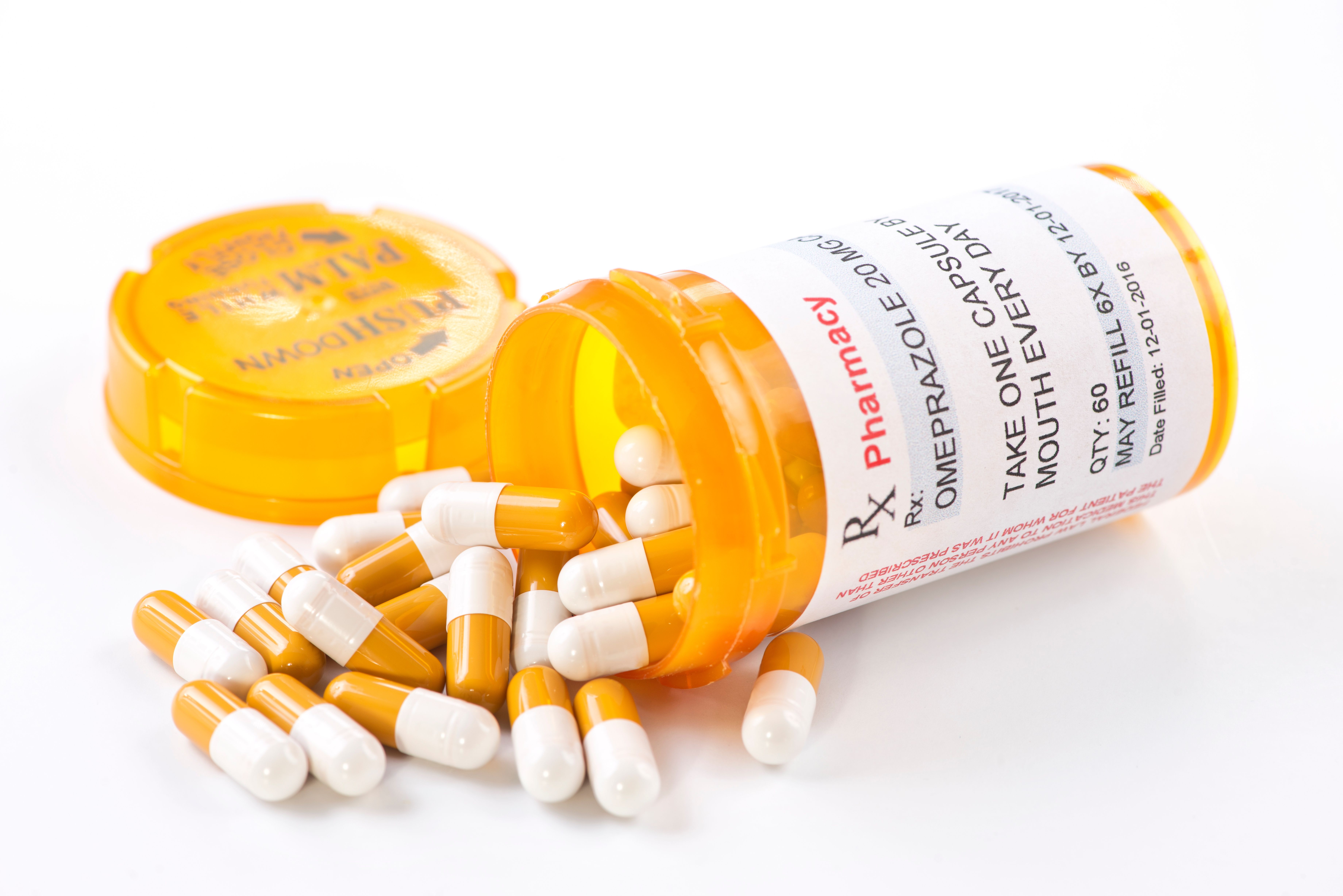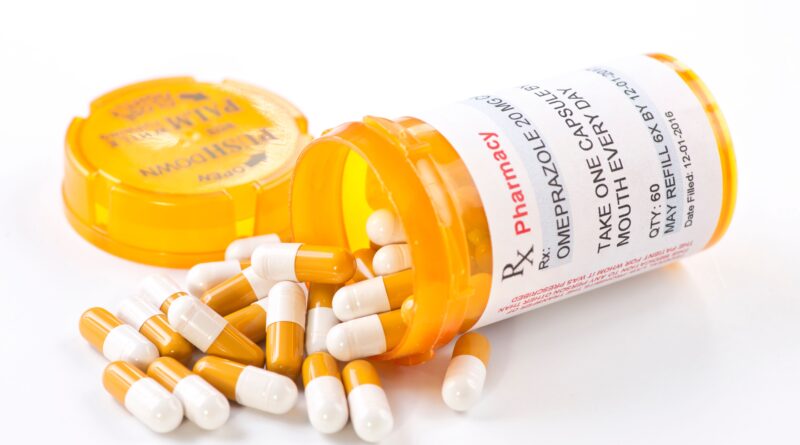Are OTC Proton Pump Inhibitors a Boon or a Curse?
Proton pump inhibitors(PPIs) are the mainstay of treatment for conditions such as gastro-esophageal reflux disease (GERD), which is caused by the reflux of excess gastric acid into the esophagus. In addition to the role of PPIs as the treatment of choice for GERD, they are also used clinically for the management of Barrett’s esophagus, Helicobacter pylori infection (along with antibiotics), stomach ulcers (often caused by overuse of anti-inflammatory drugs), and Zollinger-Ellison syndrome, among others.
Omeprazole Prescription Bottle | Photo credit: Sherry Young | stock.adobe.com

Pantoprazole, omeprazole, lansoprazole, esomeprazole, rabeprazole, and dexlansoprazole are examples of prescription PPIs currently in clinical use in the US. Of these 6 most commonly used PPIs, omeprazole, esomeprazole, and lansoprazole are also available to patients as OTC products. Since the first approval for medical use by the FDA in 1989 (for omeprazole),1 there has been an upward—and often unfair—way in the way of giving orders. As a result, there is an increase in excessive and long-term use of PPIs by a larger percentage of the US population. Furthermore, since they were introduced as an OTC product in 2003, many patients started using PPIs without a real and valid medical reason, and without medical supervision.
In the late 1990s, about 4% of US patients were using prescription PPIs. On the other hand, since they were approved as OTC products, the use of prescription-based PPIs has almost quadrupled. There is also a direct correlation between the increasing use of PPI and the number of published studies reporting the negative effects of excessive PPI use.2 On average, about 7% to 15% of all US patients, regardless of their age and gender, are using PPIs at any given time.2,3 Based on a cross-sectional study of approximately 6.8 billion outpatient visits between 2009 and 2015, approximately 600 million patients (or 8.8% of the total study population) also used prescription PPIs.3 Surprisingly, almost two-thirds of these patients were on PPIs without clear goals for health outcomes and for an indefinite and inappropriate period of treatment. And about 25% of US adults use prescription PPIs long-term (>1 year) every day. Many of these patients also regularly purchase OTC PPI products.4
This overuse of OTC PPIs can be attributed, in part, to patients’ limited exposure to biomedical science and medicine, and lack of knowledge about medical/pharmaceutical terminology. . Most patients who buy OTC PPIs do not know that they do not provide immediate relief from acidity (or heartburn), and it can be at least 1 to 4 days before they show symptoms. the benefits of treatment are noticeable.5 This completely negates the main goal that patients have, which is immediate relief from heart palpitations.
In addition, PPIs should not be used unless patients have 2 days a week or more of palpitations.6 Lack of knowledge of these clinical features is associated with frequent PPI use and may lead to transfer of treatment to patients who also have prescription PPIs. There are many research studies, systematic reviews, national gastroenterology association recommendations, and FDA warnings that highlight the increased risk of health problems such as kidney problems,3 risk of bone fractures (especially in the hip, arm and spine),6 increase in chronic kidney disease,7 increased susceptibility to infection (especially antibiotic-resistant Clostridium difficile),8 and heart disease.9 The use of OTC PPIs is not justified unless there is a long-term need and should only be used as a last resort after failure to respond to other classes of antacids such as aluminum (hydroxide) – , calcium (carbonate)-, and magnesium (hydroxide)-based antacids, as well as histamine H2 receptor antagonists (famotidine, ranitidine, cimetidine etc.).6
Pharmacists and pharmacists can play an important role in helping patients who purchase OTC PPIs by asking open-ended questions such as what other medications they are currently using and which OTC medications; who will use it (estimating patients’ age and/or gender); what symptoms they have; how long they have had those symptoms; and what other medications they have tried so far, if any. In addition, emerging studies indicate that patients on long-term PPI therapy also have 1 or more chronic health conditions, and a growing body of evidence suggests in view of the adverse effects of long-term PPI treatment in such patients. Furthermore, there is a paucity of research data examining whether there are differences related to age, gender, and/or socioeconomic status in the use of OTC PPIs that cannot be justified. For example, one study reported that PPI treatment versus placebo for the relief of GERD symptoms in infants (ages10 Thus, the therapeutic benefits of using PPIs for GERD in infants are questionable.
About the Authors
Ajay Sharma, PhD, RPh, MPharm, PGDCR, is an assistant clinical professor in the pharmacy practice department of the Jerry H. Hodge School of Pharmacy at the Texas Tech University Health Science Center, and a pharmacy manager for United Supermarkets Pharmacy in Lubbock, Texas.
Allyson Gill and Madison Gill are PharmD candidates in the class of 2027 at the Jerry H. Hodge School of Pharmacy at the Texas Tech University Health Sciences Center, and pharmacy staff at United Supermarkets Pharmacy in Lubbock, Texas.
Khemraj Hirani, PhD, RPh, MBA, MPharm, RAC, CIP, CCRP, is the associate vice chair for research and regulatory affairs in the Department of Medicine; associate director and chief operating and management officer at UM’s Diabetes Research Center; deputy director of research support in the Office of the Executive Director of Research; and chair of the Facilities and Facilities Committee at the Miller School of Medicine in Miami, Florida.
There are still unanswered questions about PPI use, and answering those may help address the many pitfalls of treatment transfer with unplanned and concurrent use of PPIs. prescription and OTC PPIs. For example, there is no online platform similar to that used by other health care professionals to track prescriptions for controlled or scheduled drugs, or products containing pseudoephedrine for sale. The availability of such a platform to pharmacists can help to analyze the number of OTC PPIs purchased by a patient per week or per month. In addition, facilitating and feeding such OTC PPI using data and history of prescription PPIs to online medication management platforms can help pharmacists to reconcile PPI therapy. and eliminate the possibility of repeat treatment with prescription-based PPIs.
Another way to reduce the chronic use of PPIs may be a computer-based platform that gives members of the pharmacy team the option to opt out of filling PPI prescriptions. Such systems must only authorize automatic refilling with special authorization and appropriate documentation confirming the reasons for the long-term use of PPI. In addition, there is a way to give a prescription to middle-level doctors, with an increased risk of prescribing too many drugs (90 days instead of 30 days), and / or the amount great for filling up unnecessarily long. Several factors may play an important role in the overprescribing of PPIs by middle-level staff, including their poor understanding of drug use and adverse effects of use. of long-term use of PPIs, their lack of knowledge about current OTC PPI use by the patient, or pressure to use the drug. secure patient business by ordering what the patient wants.
In summary, OTC PPIs can prove beneficial to patients if there is a broad and dedicated group of pharmacists, prescribers and administrators of OTC PPIs that require appropriate use. of medicine, and to reduce possible transfer of treatment. Use of OTC PPIs in conjunction with prescription PPIs.
References
1. Pediatric Postmarketing Pharmacovigilance. FDA. April 3, 2018. Accessed September 5, 2024. https://www.fda.gov/media/113569/download#:~:text=Prilosec%20(omeprazole%3B%20NDA%2019810),capsule%20on %20September %2014%2C%201989
2. Targownik LE, Fisher DA, Saini SD. AGA clinical practice update on proton pump inhibitor withdrawal: expert review. Gastroenterology. 2022;162(4):1334-1342. doi:10.1053/j.gastro.2021.12.247
3. Bustillos H, Leer K, Kitten A, Reveles KR. A cross-sectional study of gastric acid production in the United States between 2009 and 2015. PLoS One. 201813(11):e0208461. doi:10.1371/journal.pone.0208461
4. Over-the-Counter (OTC) Treatment for Heartburn. FDA. Updated November 27, 2023. Accessed September 5, 2024. https://www.fda.gov/drugs/understanding-over-counter-medicines/over-counter-otc-heartburn-treatment
5. Freedberg DE, Kim LS, Yang YX. Risks and benefits of long-term use of proton pump inhibitors: expert review and best practice advice from the American Gastroenterological Association. Gastroenterology. 2017;152(4):706-715. doi:10.1053/j.gastro.2017.01.031
6. FDA Communication on Drug Safety: There may be an increased risk of hip, arm and back fractures with the use of proton pump inhibitors. FDA. Updated August 3, 2017. Accessed September 5, 2024. https://www.fda.gov/drugs/postmarket-drug-safety-information-patients-and-providers/fda-drug-safety-communication -possible-increased-risk-of-fractures-hip-wrist-and-spine-use-proton-pump
7. Lazarus B, Chen Y, Wilson FP, Sang Y, Chang AR, Coresh J, Grams ME. Proton pump inhibitor use and risk of chronic kidney disease. JAMA Intern Med. 2016;176(2):238-246. doi:10.1001/jamainternmed.2015.7193
8. Inghammar M, Svantrom H, Voldstedlund M, Melbye M, Hviid A, Molbak K, Pasternak B. Proton-pump inhibitor use and social risk. Clostridium difficile infection. Clin Infect Dis. 2021;72(12):e1084-e1089. doi:10.1093/cid.ciaa1857
9. Higginbotham TW. Efficacy and safety of proton pump inhibitors in infantile gastroesophageal reflux disease. Ann Pharmacother. 2010;44(3):572-576. doi:10.1345/aph.1M519
10. Ariel H, Cooke JP. Cardiovascular risk of proton pump inhibitors. Methodist Debakey Cardiovasc J . 2019;15(3):214-219.
#OTC #Proton #Pump #Inhibitors #Boon #Curse
